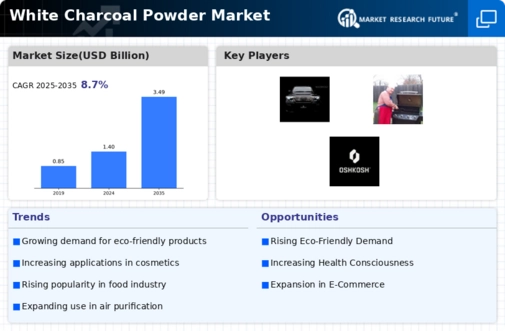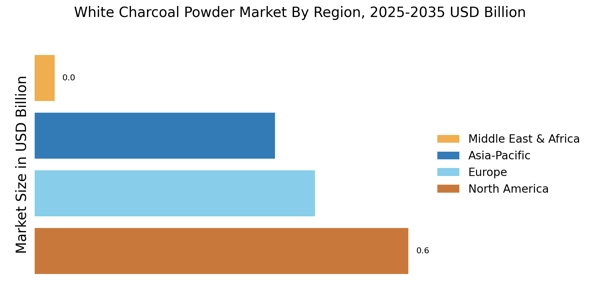Increasing Health Consciousness
The White Charcoal Powder Market is experiencing a notable surge in demand due to the increasing health consciousness among consumers. As individuals become more aware of the benefits of natural and organic products, the preference for white charcoal powder, known for its detoxifying properties, is likely to rise. This trend is supported by data indicating that the health and wellness market has been expanding, with consumers actively seeking alternatives to synthetic products. The appeal of white charcoal powder as a natural ingredient in skincare and dietary supplements further enhances its market potential. As a result, manufacturers are likely to focus on promoting the health benefits of white charcoal powder, thereby driving growth in the White Charcoal Powder Market.
Rising Applications in Cosmetics
The White Charcoal Powder Market is witnessing a significant increase in applications within the cosmetics sector. This trend is largely attributed to the powder's ability to absorb impurities and excess oil, making it a sought-after ingredient in facial masks, cleansers, and other beauty products. Market data suggests that the global cosmetics industry is projected to grow, with consumers increasingly favoring products that incorporate natural ingredients. The incorporation of white charcoal powder into cosmetic formulations not only enhances product efficacy but also aligns with the growing demand for clean beauty products. Consequently, this trend is expected to propel the growth of the White Charcoal Powder Market as brands seek to innovate and differentiate their offerings.
Expansion in Food and Beverage Sector
The White Charcoal Powder Market is likely to benefit from its expanding applications in the food and beverage sector. As consumers become more adventurous with their dietary choices, the use of white charcoal powder as a food additive is gaining traction. This powder is recognized for its detoxifying properties and is increasingly being incorporated into health drinks, smoothies, and even culinary dishes. Market analysis indicates that the health food segment is on the rise, with consumers seeking functional ingredients that offer health benefits. The versatility of white charcoal powder in enhancing the aesthetic appeal of food products while providing health advantages positions it as a valuable ingredient in the White Charcoal Powder Market.
Growing Interest in Sustainable Products
The White Charcoal Powder Market is experiencing a shift towards sustainability, as consumers increasingly prioritize eco-friendly products. This trend is reflected in the rising demand for sustainably sourced ingredients, including white charcoal powder, which is derived from renewable resources. Market data indicates that consumers are willing to pay a premium for products that align with their values regarding environmental responsibility. As a result, manufacturers in the White Charcoal Powder Market are likely to adopt sustainable practices in sourcing and production, thereby appealing to the environmentally conscious consumer. This focus on sustainability not only enhances brand reputation but also contributes to the overall growth of the market.
Technological Advancements in Production
The White Charcoal Powder Market is poised for growth due to technological advancements in production techniques. Innovations in processing methods have led to improved quality and consistency of white charcoal powder, making it more appealing to manufacturers and consumers alike. Enhanced production capabilities allow for the efficient scaling of operations, which is crucial as demand continues to rise. Market Research Future suggest that companies investing in advanced technologies are likely to gain a competitive edge, as they can offer superior products at competitive prices. This trend towards modernization in the production of white charcoal powder is expected to drive the overall growth of the White Charcoal Powder Market.


















Leave a Comment